
Wine Culture and Information since 2002 - Volume 22
 Wine Culture and Information since 2002 - Volume 22 |
|
Comparing Salice Salentino RossoSalice Salentino Rosso is one of the main wine glories of Salento, a red wine made with the famous Negroamaro grape and Malvasia Nera di Lecce |
|
In the interesting wine scene of Apulia, a region mainly known for wines made from Primitivo grape, there is a prestigious and excellent grape capable of giving quality wines: Negroamaro. Apulia, which for years has been the main provider of grapes and wines for blending, that is used for reinforcing the wines of other Italian regions which - for environmental, viticultural and meteorological reasons - were characterized by not really strong bodies. The first wines to give notoriety to Apulia have certainly been the ones produced with Primitivo grape, in particular the ones from Manduria, however in this region, where the sun shines more than in any other place, vineyards are also rich of other interesting grapes, such as Negroamaro and Malvasia Nera, protagonists of the wines of this month's comparative tasting: Salice Salentino Rosso. The wine gets its name from the homonymous city in the province of Lecce, an area having the status of Denominazione d'Origine Controllata (DOC, Denomination of Controlled Origin), where are also produced white, rose, fortified and sparkling wines. The main protagonist of Salice Salentino undoubtedly is Negroamaro, which in this wine must be for at least 80%, whereas Malvasia Nera di Lecce completes the composition of the wine for the remaining part. Negroamaro, which origins are uncertain - although it is believed it was introduced by Greeks - is one of the main red berried grapes of Apulia, capable of making truly quality wines. Also the origin of the name is not clear, it is in fact believed it is originated by the local dialect, as well as being originated from Latin and ancient Greek languages. Some believe Negroamaro comes from the dialectal expression “niuru maru”, that is black and bitter, because of the dark color of its berries and the basically bitter taste of its wines. Others believe it originates from the Latin word niger and ancient Greek word mavro, in both languages meaning black, therefore emphasizing the dark and black color of the berries. Also Malvasia Nera is characterized by dark berries, and its origin is probably from Greece. The name derives - just like any other Malvasia grape - from a Greek city in Peloponnese, known as Monemvasia, meaning “single entrance”. It were Venetian merchants to call these grapes - for assonance - Malvasia.
|
|
The territory of Salice Salentino DOC provides for the production of many wine styles, of them, the most famous and appreciated ones are rose and red. Both styles are produced with Negroamaro and Malvasia Nera di Lecce grapes, the former being present for at least 80%, the latter for the remaining part. The wines from this area are produced in the entire territory of Salice Salentino, Veglie and Guagnano municipalities - in province of Lecce - and in those of Pancrazio Salentino and San Donaci, in province of Brindisi. Salice Salentino is also produced in part of the territories of Campi Salentina - in province of Lecce - and Cellino San Marco, in Brindisi. Salice Salentino Rosso can also be produced in the styles “novello” - that is noveaux with the usual carbonic maceration technique - and “riserva” (reserve). Only wines with a minimum alcohol by volume of 12.50% and commercialized after a minimum period of aging of two years, of which at least six months in cask, can be defined as riserva.
The wines of our comparative tasting are all aged in cask or in barrique and two of them are produced as riserva style. The first wine of our comparative tasting is Resta's Salice Salentino Rosso, produced with 80% of Negroamaro and 20% of Malvasia Nera, aged in cask for 10 months. The second wine of our comparative tasting is Cantina Due Palme's Salice Salentino Rosso Riserva Selvarossa, in which Negroamaro is present for 90%, aged for 12 months in barrique. The third wine is Leone de Castris' Salice Salentino Rosso Riserva Donna Lisa, also in this case from Negroamaro and Malvasia Nera grapes, in which has been used a longer aging, about 20 months in barrique. All the wines are selected according to the vintages currently commercialized and will be evaluated at the temperature of 18°C (65°F) in ISO tasting glasses.
|
||||||||
|
The color of Salice Salentino Rosso is mainly determined by Negroamaro, a grape capable of giving wines with intense and deep colors, thanks to the good presence of coloring substances in the skin. Despite it is found in lesser quantity, also Malvasia Nera di Lecce has a good content of coloring substances, capable of giving wines with an intense ruby red color. Transparency in Salice Salentino is generally low, characteristic which is also determined by viticultural and wine making conditions: lower yields in vineyard give grapes with higher concentration of coloring substances. Because of the aging period provided for production disciplinary - at least two years - in Salice Salentino are not observed the typical color of “young” wines and characterized by a purple red hue: at the moment of commercialization it is the ruby red to be observed in the glass. With time, color of Salice Salentino tends to get a garnet red hue, and then brick red, following the usual development of red wines. Let's begin the evaluation of the wines of our comparative tasting from Resta's Salice Salentino Rosso. By tilting the glass over a white surface - such as a simple sheet of paper - we will observe the color of the wine at the base of the glass. We will observe an intense ruby red color and a low transparency. By observing the wine at the edge of the glass, we will evaluate nuances, in this case showing the same ruby red color. Let's now pass to the second wine of the comparative tasting: Cantina Due Palme's Salice Salentino Rosso Riserva Selvarossa. By observing the base of the glass - tilted over a white surface - we will appreciate a low transparency and an intense and brilliant ruby red color, the same color can be observed in the nuance. The third wine of the tasting - Leone de Castris' Salice Salentino Rosso Riserva Donna Lisa - is characterized by a low transparency and an intense and brilliant ruby red, whereas nuances - because of the long aging in barrique - show a garnet red color.
|
|
The olfactory profile of Salice Salentino is characterized by the strength of Negroamaro to which is added the subtleness of Malvasia Nera. It will however be the aromas of fruits and flowers to dominate the olfactory profile of this wine, in particular the aromas of black cherry and plum, to which are added the ones of blueberry and blackberry, including violet, the most typical flowery sensation of Salice Salentino. This interesting wine from Salento, in particular the riserva style, ages in wood containers, therefore it will also be perceived tertiary and spicy aromas typical in this production technique. In Salice Salentino can be in fact perceived aromas of vanilla, tobacco, chocolate and licorice, qualities which are accentuated with the aging in bottle. To these aromas are also added cinnamon, clover, mace and cocoa powder. Despite they are not frequent, in wines produced in this area can sometimes be perceived a balsamic aroma of menthol. The first wine of which we will evaluate aromas is Resta's Salice Salentino Rosso. By holding the glass in vertical position and without swirling, let's proceed with the first smell in order to appreciate the so called opening aromas, that is the qualities mainly identifying a wine and its grapes. From the glass will be perceived intense and clean aromas of black cherry and plum, as well as a pleasing hint of blackberry. After having swirled the glass - therefore favoring the development and oxygenation of all the other aromas, the ones requiring a higher quantity of oxygen in order to volatilize - let's proceed with a second smell. The aroma of blackberry is now strong and intense, moreover, it will be perceived aromas of blueberry, violet, dog rose and raspberry. It will also be perceived complex aromas of vanilla, cocoa powder and tobacco, result of the aging for 10 months in cask. Let's now proceed with the evaluation of the second wine of our comparative tasting: Cantine Due Palme's Salice Salentino Rosso Riserva Selvarossa. The opening of this wine is characterized by aromas of black cherry, plum and blackberry, qualities identifying both Salice Salentino and Negroamaro. After having swirled the glass, let's proceed with the second smell in order to complete the olfactory profile of the wine. From the glass will be appreciated aromas of violet and blueberry, as well as complex aromas of vanilla, tobacco, licorice, clover, cinnamon and a pleasing hint of star anise. The evaluation of the third wine - Leone de Castris' Salice Salentino Rosso Riserva Donna Lisa - gives an opening made from aromas of black cherry, plum and blackberry, not so different from the previous wine. After having swirled the glass, let's proceed with the second smell, therefore completing the olfactory profile of the wine with violet, blueberry, raspberry, vanilla, tobacco, licorice, cocoa and mace. In this wine - aged in barrique for about 20 months - should be noticed the overall aromas recalling fruit jams.
|
||||
|
The taste of Salice Salentino Rosso - as well as its aromas - it is mainly characterized by the quality of Negroamaro, a grape with a strong and robust character, softened by Malvasia Nera. Negroamaro is a grape capable of making wines with a good body and with the characteristic basically bitter taste, qualities which are, like already said, smoothed and mitigated by the more delicate Malvasia Nera di Lecce. The vigorous character of Negroamaro is also mitigated and rounded by aging - which in riserva must be of at least two years, of which 6 months in cask - therefore giving round tannins and velvety qualities. Apulia is among the Italian regions in which sunny days are more frequent than in other places, a condition helping the aging of grapes while developing good quantity of sugar, with the result of making pretty alcoholic wines. In fact, it is not rare to find Salice Salentino Rosso wines with an alcohol by volume higher than 13.5%, alcohol which is however useful in balancing tannins. Let's begin the evaluation of the first wine of comparative tasting: Resta's Salice Salentino Rosso. In the attack of this wine will be appreciated Negroamaro's tannins, not excessively aggressive thanks to the aging in cask, promptly balanced by alcohol which is perceived with its classic burning sensation. Let's now pass to the evaluation of the second wine - Cantine Due Palme's Salice Salentino Rosso Riserva Selvarossa - giving the mouth a more robust attack than the previous wine, with vigorous tannins, although already round and velvety, also balanced by alcohol which in this case is 14%. Let's now proceed with the third wine of our comparative tasting: Leone de Castris' Salice Salentino Rosso Riserva Donna Lisa. The attack of this wine is characterized by the astringency of robust tannins, also in this case smoothed by time and wood, a sensation which is well balanced by alcohol, which, in this wine, is of 14%. It should also be noticed the evident robust structure.
|
|
Salice Salentino Rosso certainly is one of the best expressions of Salento area, in which Negroamaro grape can full express its character, made more harmonic by the presence of Malvasia Nera. The finish of the first wine - Resta's Salice Salentino Rosso - is persistent, leaving in the mouth intense and clean flavors of black cherry, plum and blackberry, a pretty typical finish for this style of wine. Also the finish of the second wine, Cantine Due Palme's Salice Salentino Rosso Riserva Selvarossa, is persistent, leaving in the mouth intense and clean flavors of black cherry, plum and blackberry and, differently from the second wine, with a sensation of a more robust structure. Also in the finish of the third wine - Leone de Castris' Salice Salentino Rosso Riserva Donna Lisa - can be appreciated a good persistence, as well as intense and clean flavors of black cherry, plum and blackberry, not so different from the previous wines. In all the three wines can be perceived the vigorous character given by Negroamaro, which is perfectly balanced - also in the final phases of the tasting - by the delicate, and however important, presence of Malvasia Nera di Lecce.
|
Wines of the Month |
|
|
|
Score legend Prices are to be considered as indicative. Prices may vary according to the country or the shop where wines are bought |

|
|
Prosecco di Valdobbiadene Dry La Primavera di Barbara 2008 |
|
| Merotto (Veneto, Italy) | |
| Grapes: Prosecco (90%), Perera (10%) | |
| Price: € 11.00 | Score: |
| Prosecco di Valdobbiadene Dry La Primavera di Barbara shows a brilliant greenish yellow color and nuances of greenish yellow, very transparent, fine and persistent perlage. The nose reveals intense, clean, pleasing and refined aromas which start with hints of pear, apple and pineapple followed by aromas of wistaria, tangerine, hawthorn, peach, plum and sage. The mouth has good correspondence to the nose, a crisp and effervescent attack, pleasing sweetness, however balanced by alcohol, light body, intense flavors, agreeable. The finish is persistent with flavors of pear, pineapple and peach. Prosecco di Valdobbiadene Dry La Primavera di Barbara ferments for about 60 days in tank. | |
| Food Match: Risotto with crustaceans, Broiled crustaceans, Vegetable puddings | |
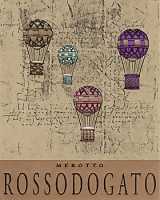
|
|
Rosso Dogato 2001 |
|
| Merotto (Veneto, Italy) | |
| Grapes: Cabernet Sauvignon | |
| Price: € 16.00 | Score: |
| Rosso Dogato shows an intense ruby red color and nuances of garnet red, little transparency. The nose reveals intense, clean, pleasing, refined and elegant aromas which start with hints of black cherry, black currant and plum followed by aromas of dried violet, vanilla, blueberry, leather, chocolate, tobacco, licorice, pink pepper, mace and eucalyptus. The mouth has good correspondence to the nose, a tannic attack and pleasing roundness, however balanced by alcohol, good body, intense flavors, agreeable. The finish is persistent with flavors of black currant, black cherry and plum. Rosso Dogato ages for 20 months in cask, 10 months in barrique and for 30 months in bottle. | |
| Food Match: Roasted meat, Stewed and braised meat, Hard cheese | |
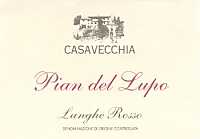
|
|
Langhe Rosso Pian del Lupo 2004 |
|
| Casavecchia Marco (Piedmont, Italy) | |
| Grapes: Nebbiolo (1/3), Merlot (1/3), Cabernet Sauvignon (1/3) | |
| Price: € 10.20 | Score: |
| Langhe Rosso Pian del Lupo shows a brilliant ruby red color and nuances of ruby red, moderate transparency. The nose denotes intense, clean, pleasing and refined aromas that start with hints of cherry, plum and violet followed by aromas of strawberry, raspberry, blueberry, vanilla, cinnamon, cocoa and menthol. The mouth has good correspondence to the nose, a tannic attack and however balanced by alcohol, good body, intense flavors, agreeable. The finish is persistent with flavors of cherry, plum and blueberry. Langhe Rosso Pian del Lupo ages for 12 months in barrique and for 12 months in bottle. | |
| Food Match: Roasted meat, Stewed and braised meat with mushrooms, Hard cheese | |
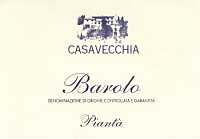
|
|
Barolo Piantà 2004 |
|
| Casavecchia Marco (Piedmont, Italy) | |
| Grapes: Nebbiolo | |
| Price: € 21.00 | Score: |
| Barolo Piantà shows a brilliant ruby red color and nuances of ruby red, moderate transparency. The nose reveals intense, clean, pleasing and refined aromas that start with hints of cherry, plum and raspberry followed by aromas of violet, rose, vanilla, tobacco, cocoa, cinnamon, anise and menthol. The mouth has good correspondence to the nose, a tannic attack and however balanced by alcohol, full body, intense flavors, pleasing crispness. The finish is persistent with flavors of cherry, plum and raspberry. Barolo Piantà ages for more than two years in cask followed by at least 18 months of aging in bottle. | |
| Food Match: Game, Roasted meat, Stewed and braised meat, Hard cheese | |
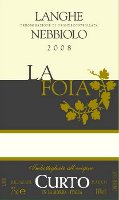
|
|
Langhe Nebbiolo 2007 |
|
| Curto Marco (Piedmont, Italy) | |
| Grapes: Nebbiolo | |
| Price: € 11.00 | Score: |
| Langhe Nebbiolo shows a brilliant ruby red color and nuances of garnet red, moderate transparency. The nose denotes intense, clean, pleasing and refined aromas that start with hints of cherry, plum and violet followed by aromas of raspberry, rose, vanilla, chocolate and menthol. The mouth has good correspondence to the nose, a tannic attack and however balanced by alcohol, good body, intense flavors, pleasing crispness. The finish is persistent with flavors of cherry, plum and raspberry. Langhe Nebbiolo ages for 2 years of which 6 months in cask. | |
| Food Match: Stuffed pasta, Broiled meat and barbecue, Stewed meat with mushrooms | |
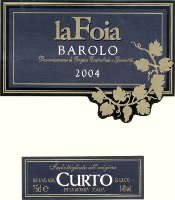
|
|
Barolo La Foia 2004 |
|
| Curto Marco (Piedmont, Italy) | |
| Grapes: Nebbiolo | |
| Price: € 27.00 | Score: |
| Barolo La Foia shows a brilliant ruby red color and nuances of garnet red, moderate transparency. The nose denotes intense, clean, pleasing and refined aromas which start with hints of cherry, plum and violet followed by aromas of raspberry, strawberry, rose, vanilla, cinnamon, pink pepper, chocolate and anise. The mouth has good correspondence to the nose, a tannic attack and however balanced by alcohol, full body, intense flavors, pleasing crispness. The finish is persistent with flavors of cherry, plum and raspberry. Barolo La Foia ages for two years in cask and for two years in bottle. | |
| Food Match: Roasted meat, Stewed and braised meat with mushrooms, Hard cheese | |
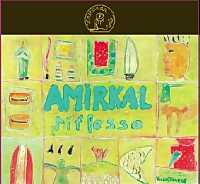
|
|
Amirkal Riflesso 2007 |
|
| Veneranda Vite (Marches, Italy) | |
| Grapes: Lacrima di Morro (90%), Cabernet Sauvignon (10%) | |
| Price: € 5.80 | Score: |
| Amirkal Riflesso shows an intense ruby red color and nuances of ruby red, little transparency. The nose reveals intense, clean, pleasing and refined aromas that start with hints of cherry, blackberry and plum followed by aromas of violet, raspberry, blueberry, cyclamen and hints of vanilla. The mouth has good correspondence to the nose, a tannic attack and however balanced by alcohol, good body, intense flavors, pleasing roundness. The finish is persistent with flavors of cherry, plum and blackberry. Amirkal Riflesso ages for 12 months in part in steel tanks and in part in barrique followed by 6 months of aging in bottle. | |
| Food Match: Roasted meat, Broiled meat and barbecue, Hard cheese | |
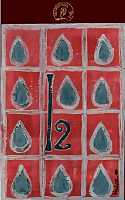
|
|
I2 2007 |
|
| Veneranda Vite (Marches, Italy) | |
| Grapes: Montepulciano | |
| Price: € 8.00 | Score: |
| I2 shows a deep ruby red color and nuances of ruby red, little transparency. The nose reveals intense, clean, pleasing and refined aromas which start with hints of plum, blackberry and black cherry followed by aromas of violet, blueberry, vanilla, tobacco, carob, mace and menthol. The mouth has good correspondence to the nose, a tannic attack and however balanced by alcohol, full body, intense flavors, pleasing roundness. The finish is persistent with flavors of black cherry, blackberry and plum. I2 ages for 10 months in barrique followed by 4 months of aging in bottle. | |
| Food Match: Game, Roasted meat, Stewed and braised meat, Hard cheese | |
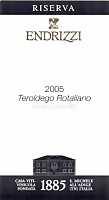
|
|
Teroldego Rotaliano Superiore Riserva Maso Camorz 2005 |
|
| Endrizzi (Trentino, Italy) | |
| Grapes: Teroldego | |
| Price: € 12.00 | Score: |
| Teroldego Rotaliano Superiore Riserva Maso Camorz shows a brilliant ruby red color and nuances of ruby red, little transparency. The nose denotes intense, clean, pleasing and refined aromas which start with hints of black cherry, plum and violet followed by aromas of blackberry, blueberry, vanilla, tobacco, chocolate and eucalyptus. The mouth has good correspondence to the nose, a tannic attack and however balanced by alcohol, good body, intense flavors, pleasing roundness. The finish is persistent with flavors of black cherry, plum and blueberry. Teroldego Rotaliano Superiore Riserva Maso Camorz ages in barrique and in cask. | |
| Food Match: Roasted meat, Stewed and braised meat, Hard cheese | |
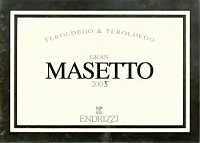
|
|
Gran Masetto 2005 |
|
| Endrizzi (Trentino, Italy) | |
| Grapes: Teroldego | |
| Price: € 32.00 | Score: |
| Gran Masetto shows a deep ruby red color and nuances of ruby red, little transparency. The nose reveals intense, clean, pleasing, refined and elegant aromas which start with hints of black cherry, blackberry and plum followed by aromas of blueberry, violet, cherry macerated in alcohol, vanilla, tobacco, mace, chocolate, cinnamon, nail polish and menthol. The mouth has good correspondence to the nose, a tannic and round attack, however balanced by alcohol, full body, intense flavors, pleasing hist of sweetness. The finish is very persistent with long flavors of blackberry, plum and black cherry. Half of Gran Masetto is made with dried Teroldego grapes and ages for 20 months in barrique followed by 6 months of aging in bottle. | |
| Food Match: Game, Roasted meat, Braised meat, Hard cheese | |
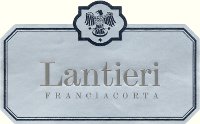
|
|
Franciacorta Satèn |
|
| Lantieri de Paratico (Lombardy, Italy) | |
| Grapes: Chardonnay | |
| Price: € 19.50 | Score: |
| This Franciacorta Satèn shows a pale straw yellow color and nuances of greenish yellow, very transparent, fine and persistent perlage. The nose reveals intense, clean, pleasing and refined aromas which start with hints of banana, yeast and apple followed by aromas of hazelnut, bread crust, hawthorn, citrus fruits, pear, peach, plum and vanilla. The mouth has good correspondence to the nose, a crisp and effervescent attack, however balanced by alcohol, good body, intense flavors, agreeable. The finish is persistent with flavors of apple, banana and plum. The base wine is aged for 3 months in barrique. This Franciacorta Satèn referments in bottle for 30 months. | |
| Food Match: Aperitifs, Fish and crustacean appetizers, Sauteed crustaceans | |
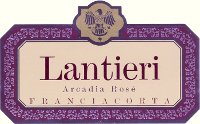
|
|
Franciacorta Brut Rosé Arcadia |
|
| Lantieri de Paratico (Lombardy, Italy) | |
| Grapes: Pinot Noir (60%), Chardonnay (40%) | |
| Price: € 24.00 | Score: |
| Franciacorta Brut Rosé Arcadia shows a pale onion skin pink color and nuances of pale pink, very transparent, fine and persistent perlage. The nose denotes intense, clean, pleasing and refined aromas which start with hints of banana, yeast and raspberry followed by aromas of cherry, strawberry, butter, tangerine, peach, cyclamen and apple. The mouth has good correspondence to the nose, a crisp and effervescent attack, however balanced by alcohol, good body, intense flavors, agreeable. The finish is persistent with flavors of cherry, banana and apple. Franciacorta Brut Rosé Arcadia referments for at least 30 months in bottle. | |
| Food Match: Cold cuts, Dairy products, Pasta and risotto with fish and crustaceans, Sauteed meat | |
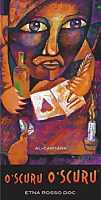
|
|
Etna Rosso O' Scuru O' Scuru 2006 |
|
| Al-Cantara (Sicily, Italy) | |
| Grapes: Nerello Mascalese, Nerello Cappuccio | |
| Price: € 21.60 | Score: |
| Etna Rosso O' Scuru O' Scuru shows a brilliant ruby red color and nuances of garnet red, moderate transparency. The nose denotes intense, clean, pleasing and refined aromas that start with hints of plum, black cherry and dried violet followed by aromas of blueberry, vanilla, cinnamon, mace and menthol. The mouth has good correspondence to the nose, a slightly tannic attack and however balanced by alcohol, good body, intense flavors. The finish is persistent with flavors of black cherry, plum and blueberry. Etna Rosso O' Scuru O' Scuru ages for 6 months in barrique followed by at least 12 months of aging in steel tanks. | |
| Food Match: Pasta with mushrooms, Stewed meat with mushrooms, Mushroom soups | |
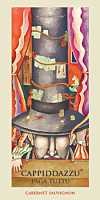
|
|
Cappiddazzu Paga Tuttu 2006 |
|
| Al-Cantara (Sicily, Italy) | |
| Grapes: Cabernet Sauvignon | |
| Price: € 19.20 | Score: |
| Cappiddazzu Paga Tuttu shows an intense ruby red color and nuances of ruby red, little transparency. The nose reveals intense, clean, pleasing and refined aromas which start with hints of plum, black cherry and black currant followed by aromas of blueberry, violet, vanilla, mace, cocoa and eucalyptus. The mouth has good correspondence to the nose, a tannic attack and however balanced by alcohol, good body, intense flavors, pleasing roundness. The finish is persistent with flavors of black cherry, black currant and plum. Cappiddazzu Paga Tuttu ages for 12 months in barrique and for 12 months in steel tanks. | |
| Food Match: Roasted meat, Stewed and braised meat, Hard cheese | |
|
||||||||
|
DiWineTaste Polls
|
| |||||||
Privacy Policy | |||||||


| Copyright © 2002-2024 Antonello Biancalana, DiWineTaste - All rights reserved |
| All rights reserved under international copyright conventions. No part of this publication and of this WEB site may be
reproduced or utilized in any form or by any means, electronic or mechanical, without permission in writing from DiWineTaste. |